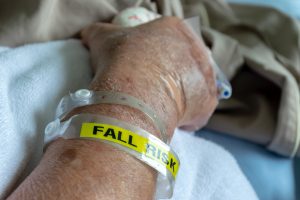May 2024
Inside This Issue
Most Frequently Cited Certification Standards:
 The May issue of Perspectives contains interesting news, updates and information, but nothing that should make you rush to implement last minute changes. Last month TJC reported on the most frequently cited and perceived high risk accreditation standards and this month’s issue of Perspectives discusses the most frequently cited certification standards and EPs regardless of placement on the TJC SAFER® Matrix.
The May issue of Perspectives contains interesting news, updates and information, but nothing that should make you rush to implement last minute changes. Last month TJC reported on the most frequently cited and perceived high risk accreditation standards and this month’s issue of Perspectives discusses the most frequently cited certification standards and EPs regardless of placement on the TJC SAFER® Matrix.
They compiled data from their multiple cardiac certification programs, orthopedic, stroke, and healthcare staffing certification programs. We noted that the cardiac, orthopedic, and stroke programs all reported DSDF.02, EP 5 and DSDF.03, EP 2 as either the number one or two most frequently cited issues and both are core expectations in disease specific care certification.
DSDF.02, EP 5 requires the program to demonstrate that it is following Clinical Practice Guidelines (CPG) when providing care. DSDF.03, EP 2 requires assessments and reassessments to be completed per patient needs and in accordance with CPGs.
While the Perspectives article does not provide percentages of clients undergoing certification and receiving an RFI for these issues, they do provide the number of surveys conducted and it is evident that the frequency for scoring these issues is very widespread. It is likely that all certification organizations are already collecting performance measures on compliance with CPGs but there may be a need to boost the desired compliance goal or strengthen the granularity of the evaluation technique.
Multiple Tenant Occupancies:
 Perspectives also contains an important article describing how TJC evaluates “multiple tenant occupancies.” In other words, buildings where you provide patient care services, but the building may be rented or shared by multiple tenants.
Perspectives also contains an important article describing how TJC evaluates “multiple tenant occupancies.” In other words, buildings where you provide patient care services, but the building may be rented or shared by multiple tenants.
There have always been questions and concerns on exactly what areas of the building TJC will look at, adjacent to, or outside of your specific space. TJC indicates that they will assess your space, plus all exits from your space to the outside at grade level; this includes shared spaces where a patient from your organization will likely travel. TJC also references an option from the Life Safety Code to separate spaces with a 2-hour fire barrier, but these may not be present in rented space.
There was an earlier article on this same subject in EC News January 2022 and discussed in the January 2022 Patton Post that provides additional details on this same issue. You may want to share both articles with your facilities and administrative leaders in offsite shared space settings, so they know what to anticipate on survey.
 Fall Precautions:
Fall Precautions:
This month’s Consistent Interpretation column discusses PC.01.02.08, EP 1 which requires implementation of fall precaution based on patient risk. Scoring is just under 4% on hospital surveys, which does not seem large, however the impact of sentinel event falls resulting in serious injury or death remains quite significant.
The article states that in 2022 there were 611 fall related sentinel events with 5% resulting in patient death and 70% in severe injury. The 2023 sentinel event data is briefly summarized in another Perspectives article this month and falls comprised 48% of all sentinel events identified. Thus, the problem and risk from falls remains very large, and missed assessment or implementation of precautions should be a focus area for performance improvement analysis.
 Telehealth Accreditation:
Telehealth Accreditation:
This month’s Perspectives also discusses TJC’s launch of a new Telehealth Accreditation program. TJC has accredited telehealth providers in the past in their ambulatory and behavioral health accreditation programs such as remote radiology image evaluation or behavioral health assessments. The new program will have a more detailed focus on requirements for equipment, devices, and connectivity, as well as the traditional focus on credentialing and privileging, provision of care, record of care, governance/leadership. The new program will launch July 1, 2024.
 Texting Update:
Texting Update:
Shortly after we published our April Patton Post newsletter, TJC posted an FAQ changing their position on texting of medication orders.
Consistent now with CMS, TJC will permit texting of medication orders providing the hospital uses a Secure Texting Platform (STP) that is compliant with the HITECH Act Amendment 2021 and the CMS Conditions of Participation. They also state the secure texting platform must be encrypted, ensure the integrity of author identification, and minimize risk to patient privacy and confidentiality. TJC also stated in their FAQ that the texted orders transmitted via the STP must be dated, timed, authenticated, and promptly placed in the medical record.
Back in 2017 ISMP had written an analysis of risks from texting medication orders and the STP appears to resolve the security of information issue. However, more classic risks of misspelling, peculiar abbreviations commonly used in text messages, autocorrect features that may not accommodate drug names and bypassing clinical decision support features reintroduce potential risks that should be analyzed before proceeding. For full details take a look at the TJC website FAQs.
 Top Scored, High Risk Physical Environment Standards:
Top Scored, High Risk Physical Environment Standards:
This month’s issue of EC News contains an article discussing the most frequently scored standards/EPs rated as high risk on the TJC SAFER® Matrix in the physical environment. Last month, Perspectives and our Patton Post discussed all the frequently scored high risk standards. This article focused just on the physical environment standards will be well worth sharing with your facilities leadership.
The article includes some specific examples of survey findings resulting from inappropriate air pressure relationships, eyewash/hazardous chemical issues and miscellaneous defects in the physical environment. Because these issues are scored deficient so often and are perceived as high risk, you might even want to consider a checklist that administrators and department heads can use on their rounding to put another set of eyes on these frequent problem issues.
For example:
- In behavioral health settings, can staff locate the environmental risk assessment for suicide hazards?
- Is each identified potential suicide hazard documented with a mitigation strategy? Please note, a mitigation strategy is not a plan to repair or renovate at some future time, it is actions to take now, to keep patients safe.
- Has the environmental risk assessment been updated within the last year?
- Do you see potential ligature hazards that are not documented on the risk assessment?
- In critical spaces, where air pressure monitors exist, are the alarms turned on?
- In critical spaces where air pressure monitors don’t exist, how do staff know it is safe to perform their services?
- In critical spaces are staff aware of temperature and humidity requirements for their work location?
- In critical spaces with temperature or humidity requirements, is the location within required parameters?
- Does the organization permit humidity to fall below 30% and if so, can staff locate the risk assessment that documents it is safe for the equipment and supplies in their area?
- Are any hazardous, corrosive chemicals in use in the work unit and if so, is there a plumbed eyewash station accessible within 10 seconds without passing through any doors?
- Has the eyewash been checked for performance weekly and is the eyewash not blocked by any stored items?
- Do staff know what to do, or who to call in the event of a hazardous chemical spill?
- Is appropriate PPE available for those staff who have to use hazardous and or corrosive chemicals?
- Are any ceiling tiles stained by water leaks in the work areas?
- Was a work order submitted to replace the stained ceiling tile and does the date reported comply with your expectation for completion?
- Are there any tripping hazards noted in the work areas?
- In patient bathrooms is the pull cord within reach of a patient who has fallen to the ground?
 EOC Management Plans:
EOC Management Plans:
This month’s EC News includes an article on the EOC management plans. Staff often detest writing, updating an evaluating these management plans, but like a bad tasting medicine, they are necessary and important. Many staff question why these plans are even required when the details are contained in multiple policies and procedures. The author of the EC News article provides the following rationales for the value and utility of these plans.
- “The plans provide leaders with a high-level view of the physical environment activities.”
- “They help the organization identify and manage risks.”
- “They help guide performance improvement efforts.”
- “They serve as orientation documents for new staff”
- “They help guide ongoing education and training.”
The author also cautions against purchasing or internet “borrowing” from another organization as these plans need to be customized to your organization. As consultants we have seen these plans with the name of a different organization or (insert the name or your hospital) in the body of the document. Such a mistake makes it clear that no one seriously tried to write a meaningful EOC plan, and that lack of effort can impact the surveyors’ impression of other observations.
EC News provides a good content outline for what summary information should be in an EOC management plan and we would encourage readers to critique their own plans against this outline to see how they might be improved.
 Laser Safety:
Laser Safety:
The last article in this month’s EC News is perhaps the most useful discussing the standards that are evaluated relative to medical laser use. Surveyors and consultants often see medical laser equipment in operative settings and that then becomes the springboard for evaluating the safety measures in place for operation of that equipment.
There are many potential questions that can be asked and often times unit staff have very little familiarity with safety precautions in place for proper use of medical lasers. Similarly, it is also often difficult to locate the right person, such as the laser safety officer, who should be able to answer those questions. Unfortunately, it is not uncommon for the laser safety officer to indicate that he/she was not aware that the location visited had a medical laser device in use.
Fortunately, EC News has provided another of their checklists to help you evaluate the safety of medical laser use in your organization. This checklist is about the most detailed we have seen on this laser safety issue, totaling 7 pages and 50 questions. We would strongly encourage readers to put together a team to evaluate the entire checklist content.
 Free Courses & Webinars:
Free Courses & Webinars:
In April, TJC published the second issue of its new subscription newsletter called Emergency Management Leader. This issue includes an article on free courses that are available through FEMA, The Center for Domestic Preparedness, The National Emerging Special Pathogens Training and Education Center, Homeland Security, The Military Health System, CDC, and The Cybersecurity and Infrastructure Security Agency of Homeland Security.
Many of these courses are webinars, thus you would not have transportation costs to participate. If you have not yet subscribed or decided not to subscribe to EM Leader, you can search free training from each of the Federal agencies mentioned above and locate their coursework and registration processes.

Tornado Readiness:
EM Leader also contains an article on tornado readiness. This past week tornados were again in the news in the Midwest, and this article suggests hospitals have a tornado safety plan as part of your emergency management planning.
 2023 Annual Report:
2023 Annual Report:
ACHC published their annual report for 2023 in April. They now have 19 different accreditation programs plus certification and distinction program options. The annual report published a very high-level summary of scoring patterns in their different accreditation programs. The high-level categories were administrative, facilities management, direct patient care, ancillary patient care, and quality/risk management.
Much like TJC, the majority of findings are in the facilities management section. Just like us, you are probably wondering what the specific findings in each category are. ACHC has also published these in a newsletter they call The Surveyor. Volume number 2 from 2023 contains those details.
Their most frequently cited standard is infection prevention 07.02.01 which includes issues such as high-level disinfection and sterilization, not following MIFU in disinfection of medical equipment, rust and dust, defects in OR flooring seams, and an old favorite on corrugated cardboard. The noncompliance rate for this one standard was huge, with 89% of those surveyed being scored noncompliant. Their second most frequently scored standard was security of medication 25.01.03 with 59% of acute care hospitals scored noncompliant.
Take a look at their website to download either the annual report or the fall 2023 issue of The Surveyor for more details on their top scored standards.
Updated SOM Appendix A:
The big news from CMS is that they updated the State Operations Manual, Appendix A for hospitals on April 19, 2024, that you can download. Content that was new in the last version dated July 2023 and printed in red, is now, no longer new and printed in black.
As we scanned through the manual, we noticed some new, red references for suicide and fall prevention. The issue we discussed last month in our Patton Post relative to consent for health professions students to perform invasive examinations for patients under anesthesia is now added to the SOM and printed in red in tag A-0955.
In the July 2023 edition there were some tags for the psychiatric hospital survey process that had stated: “Guidance is pending.” That guidance has now been published in the new SOM, but strangely it is not in red as new content. We would encourage psychiatric hospitals and psychiatric units to review these tags as accreditors are becoming very thorough in their review of the special psychiatric conditions.
You will want to download and keep your copy of the entire SOM readily available. As all of the accreditors are keeping closely aligned with CMS you may find the CMS format useful as their sometimes-lengthy narrative is quite informative, providing details and rationale you may not get from a unique element of performance from an accreditor. The CMS document is available as a PDF which makes a keyword search easy to find specific content you are looking for.
 QSO Memos:
QSO Memos:
CMS also posted two QSO memos for the home health industry in April, but these memos were just to officially expire two earlier memos from 2015 relative to change of address notification for providers and home health training. New content had been posted earlier in the year but overlooked officially expiring these older memos.

Mandatory Covid Reporting Canceled:
Effective May 1, the CDC has announced they are canceling the required mandatory reporting of Covid statistics. They advise hospitals to voluntarily report going forward, but the mandate for reporting has been lifted.

Consultant Corner
We are excited to announce that we are going to be bringing something new your way. Keep an eye out for our next month’s Patton Post!

Thank You,
Jennifer Cowel, RN MHSA
JenCowel@PattonHC.com
Julia Finken, RN, BSN, MBA, CPHQ
julia.finken@hbsinc.com
Kurt Patton, MS RPh
Kurt@PattonHC.com
John Rosing, MHA
JohnRosing@PattonHC.com
